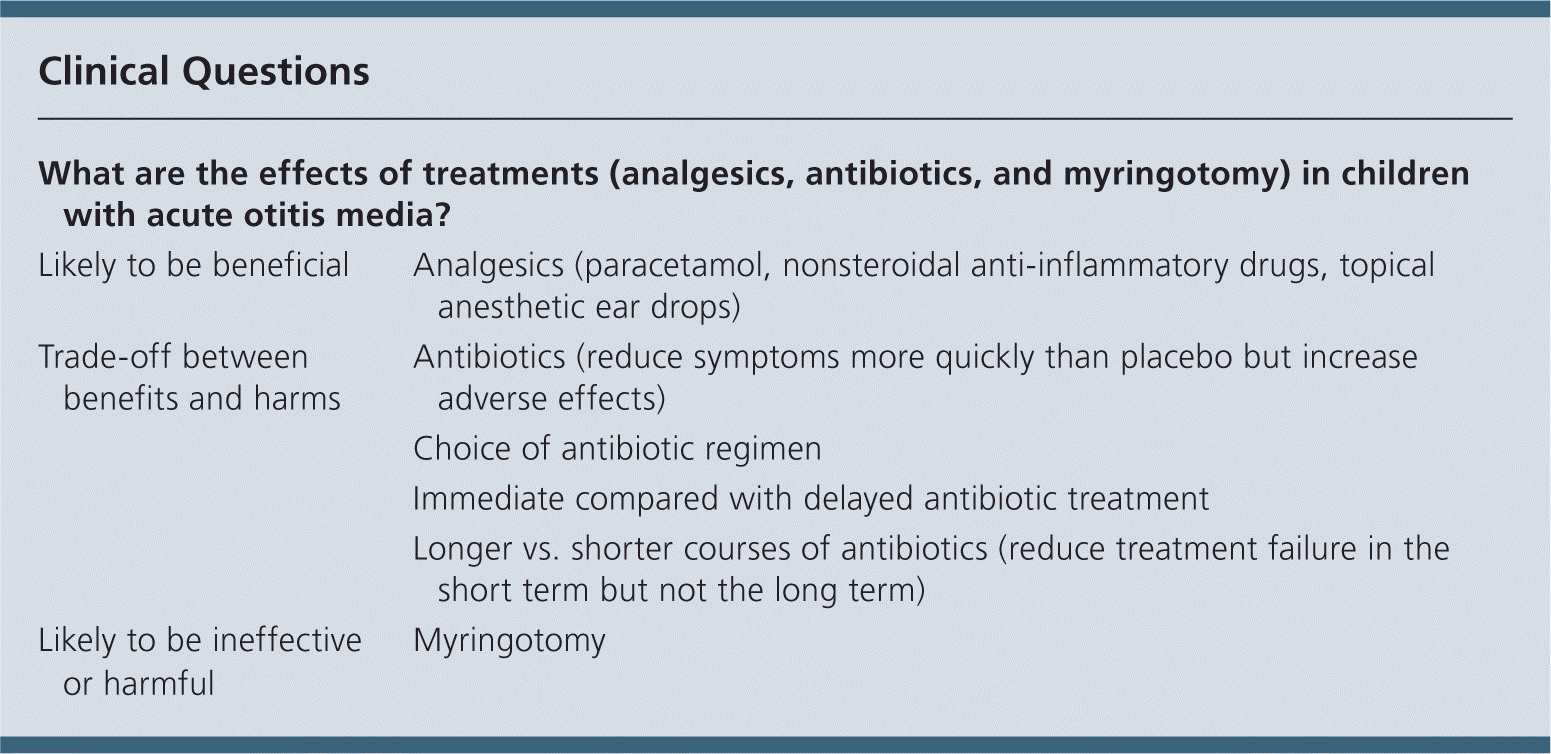
Am Fam Physician. 2017;95(2):109-110
Author disclosure: Roderick P. Venekamp and Roger A.M.J. Damoiseaux are authors of references cited in this review. Anne G.M. Schilder's institute has received a grant from GlaxoSmithKline for a study on the microbiology of acute tympanostomy tube otorrhea.
Acute otitis media (AOM) is characterized by the presence of middle ear effusion together with an acute onset of signs and symptoms caused by middle ear inflammation.
The most common pathogens in AOM are Streptococcus pneumoniae, nontypeable Haemophilus influenzae, and Moraxella catarrhalis. Local resistance patterns are important when choosing the type of antibiotic.
In the United Kingdom, antibiotics are prescribed for about 87% of AOM episodes in children's primary care visits.
Without antibiotics, the clinical symptoms of AOM resolve in about 80% of children within three days.
Analgesics (paracetamol, nonsteroidal anti-inflammatory drugs, and topical anesthetic ear drops) may reduce earache compared with placebo.
Antibiotics seem to reduce pain at two to seven days compared with placebo, but they increase the risks of vomiting, diarrhea, and rash.
We do not know whether any one antibiotic regimen should be used in preference to another, although amoxicillin may be more effective than macrolides and cephalosporin.
Immediate antibiotic use seems most beneficial in children younger than two years with bilateral AOM and in children who have AOM with ear discharge.
Immediate antibiotic treatment may provide short-term reduction for some symptoms of AOM, but it increases the risks of rash and diarrhea compared with delayed treatment.
Longer courses of antibiotics reduce short-term treatment failure but have no benefit in the longer term compared with shorter regimens (seven days or less).
Myringotomy may be less effective than antibiotics at reducing symptoms, and we found no evidence that it is superior to no myringotomy.

| What are the effects of treatments (analgesics, antibiotics, and myringotomy) in children with acute otitis media? | |
|---|---|
| Likely to be beneficial | Analgesics (paracetamol, nonsteroidal anti-inflammatory drugs, topical anesthetic ear drops) |
| Trade-off between benefits and harms | Antibiotics (reduce symptoms more quickly than placebo but increase adverse effects) |
| Choice of antibiotic regimen | |
| Immediate compared with delayed antibiotic treatment | |
| Longer vs. shorter courses of antibiotics (reduce treatment failure in the short term but not the long term) | |
| Likely to be ineffective or harmful | Myringotomy |
Definition
Otitis media, including AOM and otitis media with effusion (also known as glue ear), is one of the most common childhood conditions. Although closely related, AOM and otitis media with effusion are two different, distinct conditions. AOM is characterized by the presence of middle ear effusion together with an acute onset of signs and symptoms caused by middle ear inflammation. Symptoms of AOM include earache in older children; and pulling, tugging, or rubbing of the ear or nonspecific symptoms such as fever, irritability, or poor feeding in younger children. AOM signs include a distinctly red, yellow, or cloudy tympanic membrane. AOM diagnosis is strengthened by the presence of a bulging tympanic membrane, an air-fluid level behind the tympanic membrane, tympanic membrane perforation, and/or discharge in the ear canal.
Pneumatic otoscopy and/or tympanometry can be used to assess the presence (or absence) of middle ear effusion. In children with ventilation tubes (grommets) in place, ear discharge is a symptom of AOM whereby fluid that has built up in the middle ear drains through the tube into the child's ear canal. Interventions for ear discharge associated with ventilation tubes are beyond the scope of this review. Although most children have occasional AOM episodes, an important subset experience recurrent AOM, defined as three or more episodes in six months or four episodes in one year. Middle ear effusion without signs of an acute infection indicates otitis media with effusion, which can arise as a result of AOM, but can also occur independently.
Chronic suppurative otitis media is characterized by continuing (longer than three months) middle ear inflammation and ear discharge through the tympanic membrane (perforation or ventilation tubes). For the purposes of this review, the age range used to define children is from birth to 15 years.
Incidence and Prevalence
AOM is one of the most common childhood infections and an important reason for primary care visits in the United Kingdom. Antibiotics are prescribed for 87% of these episodes.
Etiology/Risk Factors
The most common bacterial causes of AOM are S. pneumoniae, nontypeable H. influenzae, and M. catarrhalis. There is increasing evidence that the predominant causative pathogen in AOM is changing from S. pneumoniae to nontypeable H. influenzae since the introduction of pneumococcal conjugate vaccines. Group child care outside the home and passive smoking are thought to be the most important risk factors for AOM. Other risk factors include pacifier use and a family history of AOM. Breastfeeding for three months or longer has a protective effect.
Prognosis
Without antibiotic treatment, AOM symptoms improve in 24 hours in 60% of children, and symptoms settle spontaneously within three days in 80% of children. Serious complications of AOM include acute mastoiditis, meningitis, and, rarely, intracranial complications. If antibiotics are withheld, acute mastoiditis occurs in about one to two per 10,000 children.
The authors would like to acknowledge Maroeska M. Rovers, a previous contributor to this review.
editor's note: Paracetamol is called acetaminophen in the United States.
Search Date: October 2013
Adapted with permission from Venekamp RP, Damoiseaux RA, Schilder AG. Acute otitis media in children. Clin Evid Handbook.
